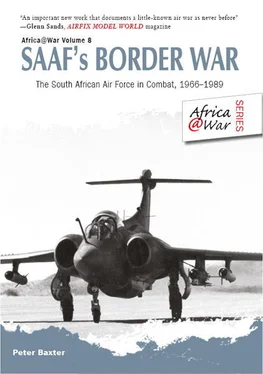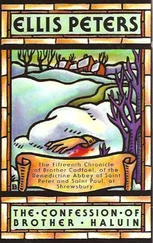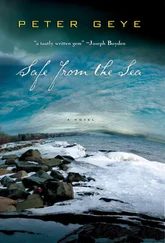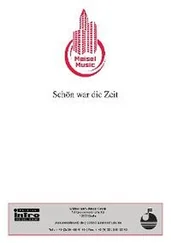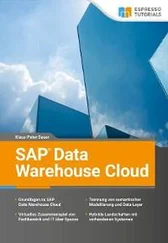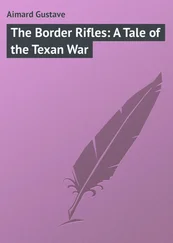Peter Baxter - SAAF's Border War
Здесь есть возможность читать онлайн «Peter Baxter - SAAF's Border War» весь текст электронной книги совершенно бесплатно (целиком полную версию без сокращений). В некоторых случаях можно слушать аудио, скачать через торрент в формате fb2 и присутствует краткое содержание. Город: Solihull, Год выпуска: 2013, ISBN: 2013, Издательство: Helion & Company, Жанр: military_history, на английском языке. Описание произведения, (предисловие) а так же отзывы посетителей доступны на портале библиотеки ЛибКат.
- Название:SAAF's Border War
- Автор:
- Издательство:Helion & Company
- Жанр:
- Год:2013
- Город:Solihull
- ISBN:978-1-908916-23-5
- Рейтинг книги:3 / 5. Голосов: 1
-
Избранное:Добавить в избранное
- Отзывы:
-
Ваша оценка:
- 60
- 1
- 2
- 3
- 4
- 5
SAAF's Border War: краткое содержание, описание и аннотация
Предлагаем к чтению аннотацию, описание, краткое содержание или предисловие (зависит от того, что написал сам автор книги «SAAF's Border War»). Если вы не нашли необходимую информацию о книге — напишите в комментариях, мы постараемся отыскать её.
SAAF's Border War — читать онлайн бесплатно полную книгу (весь текст) целиком
Ниже представлен текст книги, разбитый по страницам. Система сохранения места последней прочитанной страницы, позволяет с удобством читать онлайн бесплатно книгу «SAAF's Border War», без необходимости каждый раз заново искать на чём Вы остановились. Поставьте закладку, и сможете в любой момент перейти на страницу, на которой закончили чтение.
Интервал:
Закладка:
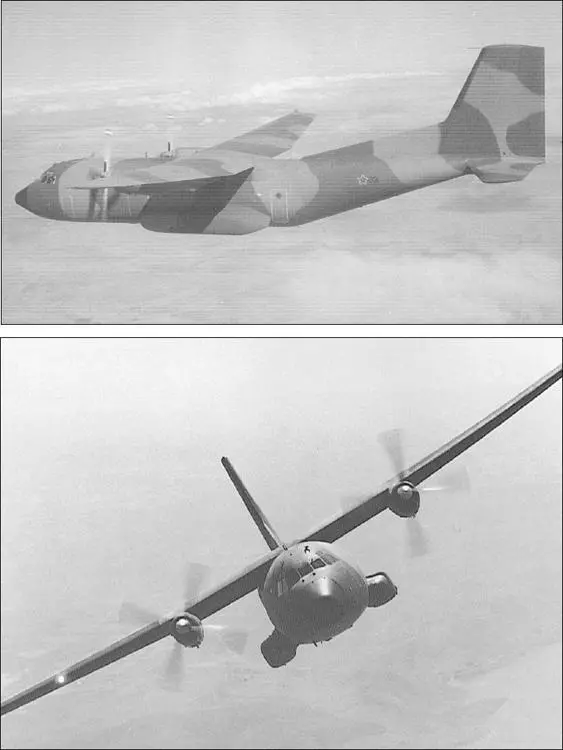
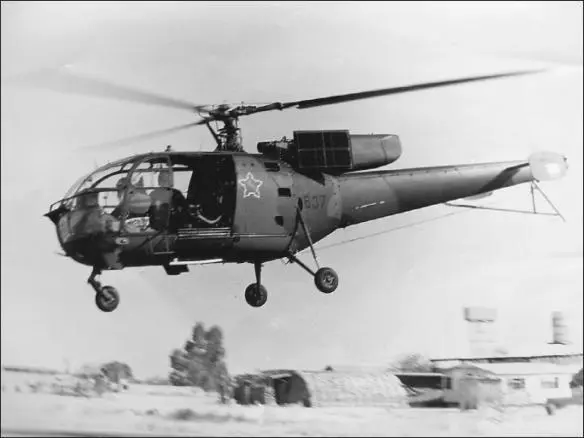

The Alouette III saw ongoing and consistent service in the SAAF during the Border War, serving as a gunship platform, as Fire Force deployment, casevac and as day-to-day troop transports. Alouettes were the first aircraft to enter the South West African theatre and the last to leave. Final formation flights of this legendary fighting machine took place over AFB Bloemspruit on 4 May 2006 and AFB Swartkop on 30 June 2006, after which the Alouette III was officially withdrawn from service.
The Puma SA 330 was an entirely different concept. Not quite the seat-of-the-pants draadkar that the Alouette was, it was developed in the 1960s to meet French and British requirements for a tactical medium-transport helicopter with all-weather daynight capabilities.
The SAAF was one of the first export customers to introduce the aircraft into service. The Rhodesians also recognized the potential of this fast, agile and versatile machine for use in the evolving conflict in that country but failed to slip the noose of an arms embargo in time to acquire any. No. 19 Squadron was formed in 1970 to accommodate the new aircraft as pilots began to emerge from training and conversion courses to fly them. In June 1972 B Flight of 19 Squadron was formed in Durban in order to use the Pumas in search and rescue, a role for which they were also ideally suited.
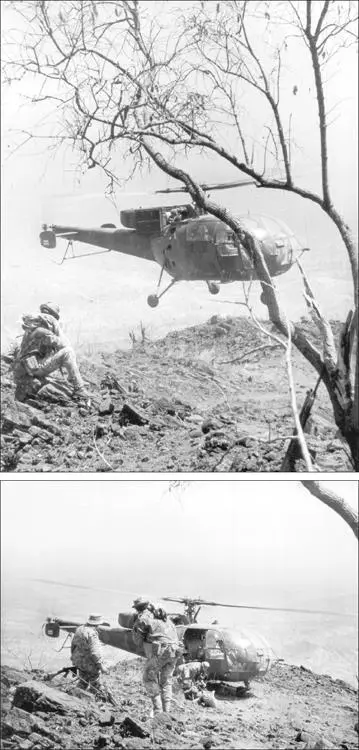
Several more similar purchases were made right up until the imposition of the mandatory UN-sponsored arms embargo in the late 1970s, which positioned the Puma as the principal muscle of the counter-insurgency war underway in South West Africa. The retractable undercarriage, sleek design and inherent agility, coupled with a 16-man troop-carrying capacity made the Puma ideal for the job. SAAF Pumas were deployed in Rhodesia on numerous occasions for Jumbo Fire Force operations, cross-border raids and other functions. The aircraft were flown by 15 Squadron (Durban), 16 Squadron (Port Elizabeth), 17 Squadron (Pretoria), 19 Squadron (Pretoria/Durban) and 31 Squadron (Hoedspruit).
The role of Pumas in the Border War was extremely varied and included normal trooping, rapid deployment during follow-up, radio relay, casualty evacuation, search and rescue and Special Forces insertion. Up until 1980 it carried a variety of weapons including the ubiquitous mounted 7.62 MAG machine guns, .50-calibre Browning machine guns, 12.5mm gun and side-firing 20mm cannon. In 1986, however, a modification was introduced that had the doors sealed shut in order to accommodate two stub wings capable of carrying the under-nose Kentron TC-20 20mm cannon slaved to a helmet-mounted site, with additional provision for four 68mm rocket pods or anti-tank and air-to-air missiles. [6] Thanks for this information to Paul Dubois published on www.satransport.co.za .
The Super Frelons, also manufactured by Aérospatiale, 16 of which were introduced into service in South Africa, was a threeengine heavy transport helicopter that did not see a great deal of service in the South West African–Angolan theatre thanks to deficiencies discovered in its operation in hot and dry conditions, and at medium to high altitude. It did make occasional appearances however, where it was flown by 30 and 15 squadrons. It was withdrawn from service in 1990 with a patchy service record, being replaced first by the more reliable Puma and later but the adapted Oryx.
The principal training aircraft adopted by the SAAF, although by no means exclusively a training asset, was the, Aermacchi MB 326M, a local variant of which was produced under licence by the Atlas Aircraft Corporation, and known as the Impala Mk I. The Impala Mk II was followed soon after, taking to the air in 1974.
A brief word on this unremarkable-looking light strike fighter would be a suitable end to this chapter. A small force of Impalas was used in the air war, becoming indispensable in a variety of roles, with reconnaissance being perhaps the most notable of these. In areas adjacent to Angola and South West Africa, where the Border War proper was fought, visual reconnaissance was carried out by Impalas in search of suspect activity for ground forces to follow up on. During these sorties the Impalas were formidably armed with the ubiquitous 68mm SNEB rockets and 30mm cannon in order to engage with enemy positions or vehicles whenever they were encountered.
Impalas also performed less glamorous work in support of ground troops, reconnaissance teams and other aircraft in external operations as airborne radio relay points – Telstar operations as they were known – and general close air support (CAS) during which pilots would wait in full readiness, often in cockpit standby, in order to provide rapid assistance to Special Force reconnaissance units operating in Angola or counter-insurgency operations in the border areas. This was tedious work when things were quiet but extremely exacting and valuable to the general war effort when they were not.
CHAPTER TWO:
THE BEGINNING: OPERATION BLOUWILDEBEES AND THE START OF THE BORDER WAR
The 1960s was an active time on the southern African revolutionary front. A rapid evolution of local black nationalist/liberation movements took place across the board with the formation of countless congresses, political parties and revolutionary fronts wherever resistance to decolonization presaged war. In southern Africa the key dominoes to fall were Tanzania, Zaire and Zambia, each of which offered rear bases for the further assault on the hardest nuts to crack: Angola, Mozambique, Rhodesia and South West Africa. South Africa would fall by economic sanctions and diplomatic pressure. No movement, not least the South African ANC, was under any illusion that that particular edifice would topple as a consequence of armed rebellion.
South Africa, however, was the military force that would confront the liberation movement for Namibia, SWAPO, or the South West African People’s Organization, the last of the great southern African armed revolutionary movements to press forward the struggle and the last to prevail.
SWAPO was very much cut from the cloth of regional nationalist liberation movements, each of which represented the evolution of much association-forming and modern political orientation, all of which also coincided with the emergence of the first generation of young and radical black intelligentsia. Prior to this, black political language had tended to be restrained and organizations on the whole were law-abiding and sought, rather than to overthrow white minority rule, to work to ameliorate the poor social and wage conditions of blacks from within the system. The progressive toppling of colonial rule farther north generally had a radicalizing effect on the youth of the southern African region who, competently led for the most part, began to agitate with increasing violence for full political independence.
In the 1960s this low-level violence rarely exceeded what might be regarded as civil disturbance and was dealt with by the civil authority backed up when necessary by emergency powers. This gradually began to transmute into an armed struggle as political links were established between the various nationalist leaderships and Eastern bloc countries, in particular China and the Soviet Union, but many others at various times. This resulted in the training and arming of guerrilla movements and the establishment of rear bases in friendly liberated countries as part of the unofficial mandate of the so-called Front Line States and the more formalized policy of the Organization of African Unity.
Читать дальшеИнтервал:
Закладка:
Похожие книги на «SAAF's Border War»
Представляем Вашему вниманию похожие книги на «SAAF's Border War» списком для выбора. Мы отобрали схожую по названию и смыслу литературу в надежде предоставить читателям больше вариантов отыскать новые, интересные, ещё непрочитанные произведения.
Обсуждение, отзывы о книге «SAAF's Border War» и просто собственные мнения читателей. Оставьте ваши комментарии, напишите, что Вы думаете о произведении, его смысле или главных героях. Укажите что конкретно понравилось, а что нет, и почему Вы так считаете.
